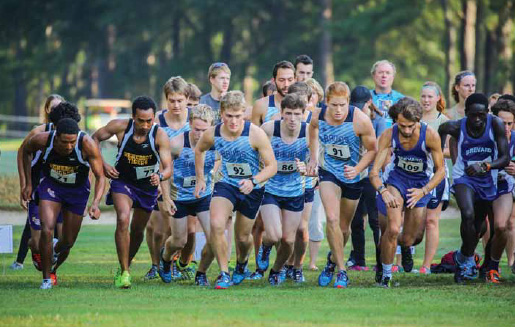| Start-Up Challenges and Opportunities for New Programs |
| By: Landon Bright
Originally Published in: Techniques Magazine Provided by: USTFCCCA One would expect that women's offerings have increased, but even men's programs in cross country, indoor track, and outdoor track have increased since the 2005-2006 NCAA season. In men's cross country, the total amount of teams has increased by 12 in Division I, 46 in Division II and 57 in Division III (National Collegiate Athletic Association, 2016). Although programs continue to be eliminated from college offerings, we still see a net increase in the NCAA. Some of these numbers can be attributed to institutions changing divisions, most recently NAIA schools switching to NCAA Division II, but the numbers still provide a positive framework moving forward for the sport at the college level and for coaching opportunities in all divisions. The biggest jumps have been in smaller associations, whose administrations tend to see cross country and track and field as an effective and affordable way to increase student enrollment and their athletic offerings. For example, the number of NCAA Division III women's out door track and field programs has increased from 258 teams in 2005 2006 to 313 in 2015-2016 (National Collegiate Athletic Association, 2016). The NCAA numbers do not reflect the many additional programs that have been started at smaller institutions that compete in other associations, including the NAIA, USCAA, NCCAA, and various junior college associations. As colleges continue to look for ways to increase their offerings for potential student-athletes, both cross country and track and field will continue to be included on the short list of possibilities. With this increase, many coaches have had the opportunity to start new programs. Some have been completely from scratch and others have been additions to already existing complementary programs, such as a school starting outdoor track and field after offering cross country for a few seasons before. I have been a part of two new programs, as both a graduate assistant and a head coach. Although it is an exciting opportunity, starting a program presents challenges that can quickly lead to frustration and burnout. If coaches are persistent and identify potential roadblocks, starting a program can be one of the most rewarding experiences of your career. Although the challenges will vary depending on the program, such as scholarship vs. non-scholarship, the following points are major areas that will most likely face the majority of new programs. Despite the many challenges, starting a new program also presents various opportunities to set the tone for a successful program from the start. These points are most directly related to college programs, but they can also be applicable to new youth clubs, high school teams and even post-collegiate programs. FADING EXCITEMENT Momentum is one of the biggest benefits of a new program. Administrators, alumni, parents and students will all show excitement over a new program, regardless of the sport. A new sport is shiny and has endless potential. All the equipment, uniforms and gear are new. Incoming and current students will jump at the opportunity to be a part of school history, even if they have limited experience in the sport. These are all positive aspects of adding a sport, but eventually the momentum fades and a program transitions from new to old. There will be challenges with student-athletes, faculty, administrators, and potentially parents, which take the shine off a new program. Even as a coach, you may not have the energy and excitement you had leading up to your program's first season. This is all to be expected. Successful programs look to be consistent without being celebrated. This is a difficult transition, but growing your program from a start-up to an established program offers a tremendous learning experience. Much like our student-athletes, coaches must learn to be persistent and motivated, even if momentum is not moving forward. LIMITED RESOURCES Many institutions looking to start a new program want to do so on a limited budget. This may mean it will be several years (or decades) before you can build a facility. It may mean hit ting certain numbers before adding full-time assistant coaches. Every pro gram will be different and choose to allocate funds how they see fit. If you are starting a program at a smaller school, you will most likely not have the resources of an established program. If you embrace this fact, it will help curb potential frustrations. The best way to overcome this is to be creative. If you do not have a facility, establish a relationship with a high school that does. If you do not have assistant coaches, create a program where volunteers, graduate assistants, and even student managers are celebrated. Sometimes having fewer resources can lead you to be a hungrier coach, which is a trait you can pass down to athletes. I like to remind my student-athletes that some of the best track and field athletes come from regions where there are little to no all-weather tracks. Ultimately, our sport is designed to be accessible to all and that includes small-budget collegiate programs. As a new program, your alumni base will be non-existent for several years. This could potentially hinder the fundraising capabilities for your program early on. It will be difficult to raise money specifically for cross country and track and field for your school when there are very few alumni and most have just started their careers. This is certainly a disadvantage,but starting a program provides the opportunity to easily keep track of every student-athlete that has been through your program. If you are organized, you can update mailing and email addresses of alumni for future use. Although the alumni office of your institution will probably do this, your alumni will increase every year, so it will be easier to keep your own database up-to-date to use when you wish. This information can be used to organize alumni events or fundraising campaigns. Although there are few immediate rewards to tracking alumni, having a complete list will make it easier for you to connect with former student-athletes, which will increase their support of the program.  Success may not come right away. There are programs that see success very early, but it may take you and your program several seasons before you reach the success you first imagined. As coaches, this can be a troublesome realization. It's difficult to accept mediocrity or below-average outcomes, but if you are invested in the program and are putting in the work, the mediocrity will not last for long. The temptation will be to give up when success is not first realized, but if you are consistent and competitive, you will care less about the immediate results and focus on the habits that lead to long-term success. With new programs, it will be easy to make excuses for your potentially slow start. But you must remember that every college has its pros and cons. You will have unique challenges that will make it harder to succeed. Instead of focusing in on your schools problems, write down a list of what makes your school unlike any other institution. This will help shift your focus from the negative to the positive. In his book Road to the Top (1995), Coach Joe Vigil wrote about the size of the city and school when he coached many top athletes at Adams State University. "The advantage of living in a small community and attending a small institution (3,000 students) is that it allows the athlete and coach to have several encounters during the day, in addition to the main training lessons." He goes on to write, "It has given me, as the coach, an opportunity and the environment to discover the many gifts that my athletes have possessed" (p. 248). Coach Vigil gives us a great example of taking a possible negative of being at a smaller institution and turning into a positive. Although, his program was well-established by the time he wrote the book, he provides a blueprint for how to avoid the shortsightedness of your school's potential negatives features. ENROLLMENT One of the major reasons institutions add an athletic program is the potential to increase enrollment. Administrators may see the large numbers that athletic programs at other institutions bring in and want to replicate it. This is a great advantage for our sport, but if you are a smaller school who's immediate and long-term future depends on the enrollment of a small number of students, this can be a daunting and stressful task. You may be asked to hit certain numbers, which is not as easy as it sounds. Your dream of being a coach can quickly turn into a position that seems closer to desperate salesman. The temptation will be to bring in any student who shows interest in the program. This may be beneficial early on, but as you enter into your second or third season, you will want to make sure to bring in student-athletes who fit your team dynamic and are invested in the program long-term, even if it means a smaller team. Clear communication with administration is key. Explaining your recruiting and retention plan early on, even if it changes over time, can cut down on potential conflicts. Be sure to cast your vision of the program in a realistic, but optimistic way. If you make big promises early on, it will make the challenges that much more frustrating and stressful when they come about. Administrators specifically see cross country as an affordable way to increase the student-athlete population. Their inclination is correct, but this is not an overnight formula. For smaller schools, especially non-scholarship institutions, building the student-athlete population through cross country and track and field will mean having the patience to build a program that keeps and not just recruits students. This requires patience on the part of both coaches and administrators. It means the coach will have to take time to build a quality program and not only focus on bringing in as many student-athletes as possible. It will be important for athletic directors and their superiors to understand that the school's investment will be beneficial, but it may take a few years before consistent success is realized.
One of your first steps when beginning a new program will be coming up with a recruiting plan. Depending on when the school's administration approved the program, coaches will have various lengths of time to recruit student-athletes. Coaches will most likely not only be behind on recruiting current high school seniors, but could also be late on contacting high school juniors. Some coaches are brought in just several months before the first season, making it very difficult to put together a competitive team the first season. It is important to note that a late start in recruiting will not just influence that first season, but could have potential ramifications for three to four seasons. It may take up to five years for each class of student-athletes to have similar numbers. Hopefully, your program can begin with healthy and consistent numbers, but it could take some patience and determination on your part. Despite the many challenges in recruiting for a new program, there are also many advantages. You will be able to highlight the opportunity for potential student-athletes to be the pioneers for the program. Going to an established program has many benefits, but for some recruits, being able to set the tone for a new program can be a potential draw for them. Even the idea of holding a school record the first couple of seasons can be something to mention to a potential student-athlete. It will be important to give these early student-athletes a good athletic and academic experience, as they will be the ones promoting your program to their friends, family and contacts in the future. As mentioned in the limited resources section, your alumni base will be small the first few years and this will also potentially influence recruiting. However, even if your program is not competitive the first few seasons, student-athletes who have a great experience can be one of your best recruiting tools in the future. CONCLUSION Ultimately, when a new program is launched and is in early phases, it is key for the coach to have an equal mix of enthusiasm and tempered expectations. At some point, every program had a beginning, and it is unlikely that even the successful ones started off as an elite program. Many of the top programs of today have been around for numerous decades and have had an opportunity to build up prestige and trophies over several generations of student-athletes. This is not an excuse to not recruit and compete well, but it can provide some perspective if you are trying to get a new program off the ground. I will sometimes research the early years of successful programs to remind myself of the various ways these programs started. Sometimes they were competitive right away, but others took a slow build-up before becoming consistent winners. It could be the case that you will not be the coach in place when the program gains traction, but hopefully you made decisions that put the program on a positive trajectory from the start. If we want the opportunities for college programs to exist and continue to rise, it is important for every coach to leave his or her program in a great place for the next coach to take over. As coaches, we sometimes get into a scarcity mentality, believing there can only be so many successful programs. Although only one school will win your division's championship, the opportunities for a successful programs do not have to only belong to the few. This will be vital for new coaches to process. If you can measure success in ways outside of championships, it will both increase your motivation and lead to a high quality program for the student-athletes. I have found that the single most important step I can take as a coach of a new program is to plan as though I will be there for a long time. This mindset will free you from the frustrations of the daily challenges of starting a program. Even if you are a graduate assistant, part-time coach or volunteer, this mindset can be extremely beneficial. If you show up to your office and to practice with a long-term vision, the day-to-day operations will fall into place. This is probably true for every coach, but is especially beneficial for those overseeing new programs. Your career may take unexpected turns or you may have greater aspirations, but having a long-term focus will be more beneficial for your career than updating your exit strategy after each frustrating event. It will be crucial to make long-term goals alongside your season-to-season goals. Your student-athletes will also benefit from a coach that is focused on being with the program through its early struggles. Like improving athletic performances, improving new programs is about repetition. There may not be clear improvement at every meet, but with continual healthy optimism and a long-term outlook, coaches can maximize their enjoyment of starting a new program. They will put themselves in a position to help individual student-athletes improve and hopefully provide a lasting positive impact on their institution. REFERENCES National Collegiate Athletic Association. (2016). Student-athlete participation: NCAA sports sponsorship and participation rate report (1981-82 - 2015-16). Indianapolis, IN: Erin kick Vigil, (1995). Road to the top. Albuquerque: Creative Designs, Inc. ------------------------------------------------------------------------------------------------------ Landon Bright joined the Bob Jones University staff in June 2013 as the cross country pro-gram's first head coach. Prior to his time at BJU, Bright served as a graduate assistant coach for cross country and track and field at Hardin-Simmons University (TX |




 Over the last decade, frequent headlines have circulated of cross country and track and field programs being eliminated. Despite losing the occasional program, the number of NCAA programs across all divisions has gone up for both cross country and track and field in the last 10 years.
Over the last decade, frequent headlines have circulated of cross country and track and field programs being eliminated. Despite losing the occasional program, the number of NCAA programs across all divisions has gone up for both cross country and track and field in the last 10 years. RECRUITING
RECRUITING


